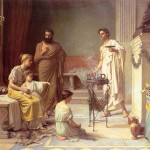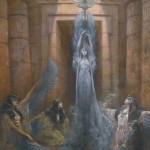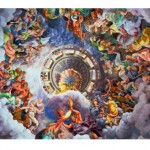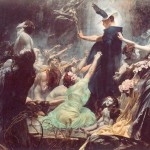Tyrannius Rufinus tells this story of the destruction of the Serapeum of Alexandria late in the 4th c. A.D.:
One of the soldiers, better protected by faith than by his weapon, grabs a double-edged axe, steadies himself and, with all his might, hits the jaw of the old statue. Hitting the worm-eaten wood, blackened by the sacrificial smoke, many times again, he brings it down piece by piece, and each is carried to the fire that someone else has already started, where the dry wood vanishes in flames. The head goes down, then the feet are hacked, and finally the god’s limbs are ripped from the torso with ropes. And so it happens that, a piece at a time, the senile buffoon is burned right in front of its adorer, Alexandria. The torso, which had remained unscathed, was burned in the amphitheatre, in a final act of contumely. […]
A brick at a time, the building is taken apart by the righteous (sic) in the name of our Lord God: the columns are broken, the walls knocked down. The gold, the fabrics and precious marbles are removed from the impious stones imbued with the devil. […]
The temple, its priests and the wicked sinners are now vanquished and relegated to the flames of hell, as the vain superstition (paganism) and the ancient demon Serapis are finally destroyed. (Historia ecclesiastica 2:23)
This is but one tale from the early Church Fathers of the destruction of Greek, Roman, and Egyptian sacred icons as Christianity rose to power in the Late Roman Empire. Starting in 389 A.D., Emperor Theodosius progressively decreed forbidden feast days and public sacrifices, and in 391 he commanded that “no one is to go to the sanctuaries, [or] walk through the temples.” These are clearly methods for suppressing the traditional religions of the majority of the inhabitants of the Empire. Yet as we restore the worship of the Ancient Gods today, it is well we reflect on the spirituality necessary for the Christians to perform these acts of iconoclasm and contumely.
Most in our culture today are familiar with the ancient accusation of idolatry leveled by the Hebrew Prophets and others in the Bible against neighboring religions. The use of sacred icons as objects of worship was and remains commonplace outside of the Abrahamic traditions. For them, the use of imagery (especially anthropomorphic, but also zoomorphic forms) was forbidden by the Third Commandment of the Decalogue (Ex 20:4-6; Dt 5:8-10; etc.), and this commandment led to the general suppression of depictive art. Geometrical forms and calligraphy became high art forms in these cultures. (In some time periods this stricture was relaxed, but not generally for objects of worship.)
Catholic and Orthodox traditions engage in veneration (dulia) of iconography, which is seen as an acceptable but lesser form of spiritual engagement. The greater spiritual engagement of worship, technically termed latria or service, is reserved for their God. The Abrahamics are not the only aniconic traditions, however. The early Irish Celts and the early Buddhists both were, for example, and the impulse to not image the world or its inhabitants is ancient and widespread, if sporadic. Friction between iconic and aniconic peoples have at times led to significant violence, as the destruction of the Serapeum above typifies.
But the need to destroy the icons of a religion does not merely suppress the religion’s material culture. There is a profound spiritual, or we might say magical, reason for the destruction. The Icons, or idols as their detractors would call them, were not simply works of stone, wood, porcelain, metal, or such. An Icon might be a work of high art or an unhewn stone, but in every case it was seen as an embodiment of the Deity worshiped through it. For this reason, the Icon was literally worshiped or offered latria or Divine service (as the Romans put it). This term is the basis for the word idol-latria.
For its detractors, this practice was the height of folly or the depth of sin. Their polemic centers on the worship of a stone or block of wood, an object made by human hands. Yet there is no evidence that the ancient peoples, or our contemporaries for that matter, confuse the Icon with the God, any more than we confuse a telephone with the person we are talking to. But you would not necessarily know this by listening to the speech of priests engaged in worship.
In worship, the Icon is typically addressed as though it is the person of the Deity. Whether giving words of praise, making food offerings, or dressing the Icon or shrine, the Icon is typically addressed as though there were a person present there. The reason for this behavior is that the Icon is the Deity, or more properly an incarnation of the Deity, what we might call today an instance. The ‘actual’ Deity is of course a structure of the world (at least for Pantheists)—that’s what makes that Being a Deity. But the image, often anthropomorphic, is considered to hold the spirit of the Deity.
The Icon has come by this status ‘naturally’ as do the sacred stones, often meteorites, worshiped in many cultures. A constructed Icon may have been consecrated by the priestfolk who invited the essence of the Goddess to dwell within it. Thereafter, the Icon was treated as the Deity, offered hymns and material offerings, and had prayers addressed to it. In response, the Deity blessed the city and the people and at times granted their prayers. Deities being characteristically present throughout existence might be said to be especially concentrated or present in an Icon. Or the Icon might serve as something like a telephone, as though the ear of the Deity were in that place (a common motif in Egypt). Long worship and regular offerings made the Icon a powerful locus of the Deity’s presence. These practices made the Deity especially welcome and disposed to granting Her or His benefits at that place. One could think of these statues and sacred objects as anchorages for the Gods, holding them to the human world and making them accessible to humankind. This is why those Icons had to be destroyed by the practitioners of competing religions.
For a trained and practiced priestess or priest, witch, or mage, access to the Gods is readily available through invocations and offerings. For the common person, who does not know the “order of the sacred observance, its holiness and [the] long-protracted endurance of toils, and, . . . the customs, prayers and other rituals” (Iamblichus, De Mysteriis, 2004, p. 153) that enable Divine contact, the consecrated Icon was the principal place they came to offer worship and ask boons. To break a peoples’ contact with the Gods, one must destroy and desecrate the Icons of their Gods. Yet if we know how to destroy contact with the Gods, we also know how to undo the damage.
The proper animation of statues is not complicated or difficult, nor does it require exotic materials. It does require the ability to invoke the Gods, or rather the Deity desired to be incarnate in the Icon. Since this is invocation “outside” it is technically evocation, but remember one cannot compel a God: one invites. The procedure is generally performed by the Deity, usually in the form of one of Her Priests who has duly invoked (after significant preparation) and thereby become possessed by the Deity. This may or may not involve the submersion of the personality of the priest or priestess. The possession may be as light as a mantling with the God-form. The degree of possession is not as important a dimension of the process as one might think, because it will be the Deity that is doing the actual work. This is one of the reasons this practice is termed Theurgy: God work. The priest/ess is just the material vehicle.
Next, the statue or other object that will become the Icon is duly purified and generally consecrated. In ancient times it would be ‘sacrificed’—that is, made sacred, sometimes by being dedicated by the maker or the person or persons who sponsored its creation. Many Icons have hollow spaces in them to put sacred materials that we would say ‘correspond’ to the Deity. These would also be purified and consecrated before being placed in the Icon, perhaps with due ceremony and invocation.
In this manner, the material object was made a suitable habitation for the Spirit of the God. The Deity then, in the form of the priestess, would ‘call down’ or otherwise make present another instance of Her Spirit and place it within the statue, making it an Icon. Worship would then be rendered the Icon and offerings made to what was previously lifeless stone and now a God. Thereafter, the Icon would bear the presence of the Deity and be treated accordingly. Like a talisman holding that presence, It would radiate Its blessing on the region and all who came to worship.
This is what we must do again as part of our restoring the Way of the Gods. Animating Icons will make the Gods more present in our world and make their Power and Blessings more accessible to our lives.
Recently, at Pantheacon 2013, a six-foot tall, one-foot-by-one foot block of pine, shaped into a geometrical Herm or square pillar, was animated with Spirit of Hermes and rendered worship. It now dwells in The Sacred Well store (by the cash register, it is Hermes after all) by Lake Merit in Oakland, California. At the Dark Moon each month folks gather to worship and receive the blessings of Hermes Pantos Apolytos, Hermes All Liberating. Io Hermes!












